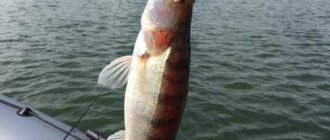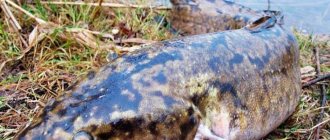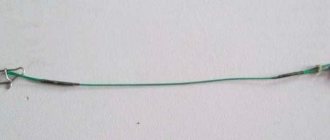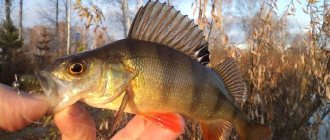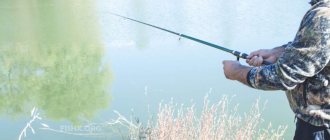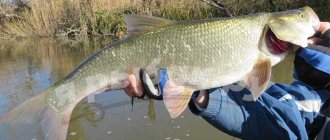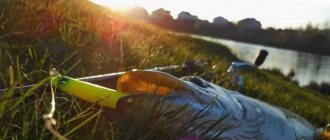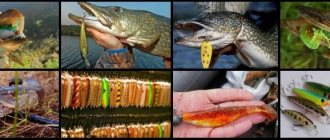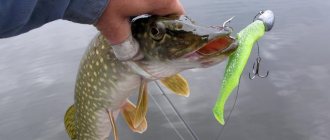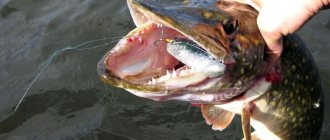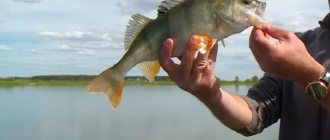Pike in late autumn, what and how to catch? In the article, I will tell you what baits I use when fishing for pike in late autumn and how to use them correctly.
The off-season, which is the transition period between late autumn and winter, often negatively affects the activity of underwater predators, including pike. But if you choose the right gear, bait, tactics and fishing strategy, then it will be too early to close the season.
Why use big baits?
Why is such a seemingly inflated “load capacity” of a spinning rod and the size of a spinner or twister needed? The fact is that autumn fish no longer tends to the grassy shallows, where in the summer there was a lot of food and warmth for silvery fish and, accordingly, a fertile food supply for all predators. No, with the colder weather, all aquatic creatures now go to deep places, where most fish from the carp family will remain in wintering pits until spring. And only roach, silver bream, and bream will actively feed, and even then with periods of extinction of the bite and with some improvements in clear weather and even pressure.
Autumn. Pike near the hole
Somehow the summer season passed quickly, remembered by spinners for the hot weather (especially in August), not the best predator activity and other highlights typical of summer. September has also flown by, which is time to be called a continuation of August. October is just around the corner. Thank God it’s gotten colder and autumn at least looks like autumn. And if quite recently, when trying to catch pike, we enthusiastically fished grassy shallows or other shallow areas, then with the onset of autumn we have to noticeably shift our emphasis. As you know, schools of forage fish now gravitate towards the pits, followed, of course, by pike. It is about catching toothy fish near the deepest places that I would like to share my observations. Without a doubt, pike fishing in the fall is a promising activity, because the time is golden. However, quite often you still have to return home with nothing, wondering for a long time about the reasons for the fiasco and missed opportunities. One of the main reasons for failure is, in my opinion, the wrong fishing location. It is clear that it is impossible to say in advance exactly where the predator will be, but it is precisely the vicinity of the pits, according to my fishing statistics, that are the most win-win places. I would say there are almost always pike here. This is true both for bodies of water with and without current. About pike movements
It is perhaps wrong to recommend fishing in the pit itself, since this is not where the specimens ready to eat are usually found. Sometimes even fishing directly at the edges of the pit does not give a significant result, and the lion’s share of bites occurs in the surrounding area, located fifty or more meters from the pit. Actually, there is nothing surprising and what has been said absolutely does not contradict the theory or ordinary fishing observations, which state that a passive predator usually dozes at depth, but hungry specimens guard the surrounding area and often move away from the pit to a fairly decent distance.
In relation to rivers, I noticed many times that often the same pike points located near the pit worked stably in both September and October. I don’t know if there was a kind of changing of the guard there (some pike left the hole, while others returned), but a certain part of the “duty” fish were constantly in a state of hunting, even if they did not rush to all the baits in a row indiscriminately. Due to the often small size of our rivers, I have never noticed significant migrations of pike with the onset of autumn. The toothy one simply sank to lower horizons and moved to deeper areas. Thus, the vicinity of the pits was replenished with specimens that, with the cooling, came here from grassy shallows and other similar summer sites.
At reservoirs the picture looks somewhat different.
In fact, on rivers whose banks are overgrown with a solid wall of reeds or entire fields of water lilies, pike move according to the schedule of reservoirs. Observations say that the predator spent its “summer vacation” in the thickets, being out of reach for most spinners. Sometimes the toothy one fully hunted here, but most often it was half asleep and it was practically impossible to lure it out of the grass. And only with the onset of autumn did the pike begin its movement towards the wintering pits, making rest stops along the way and periodically filling its belly with food. One way or another, the pike route in the next month and a half ended near the pits, where by that time the concentration of toothy fish had grown noticeably. In general, I would happily recommend that my colleagues concentrate their efforts on the pits. The best places
It is traditionally believed that the most promising place is the entrance and exit from the pit, the rest are so-so. Sometimes it is quite possible to achieve success using such coordinates, but often this is too superficial and inaccurate information. Analyzing the results of my fishing trips, as well as the experience of my spinning friends, I identified specific points within different holes where the results were the best. At first this list was separate for rivers and reservoirs, but later I realized that, despite the noticeable difference in the nature of the reservoirs, in reality everything is very close. I present a combined list of top pike spots.
1. The entrance to a hole on the river, if it is an area with a rapid, where algae grows in places at the bottom, and the depth is at least two meters less than in the hole itself. The entrance to the pit is a priori interesting for fish, but especially in the fall. In this case, the most promising thing would be a deep dive, but the next fifty meters should definitely not be overlooked. 2. The area of the reservoir where the pit adjoins shallow, grassy shallows. In this place, the path of the above-mentioned pike migration from summer stopping places (shallow waters) to autumn ones (pits and their environs) is the shortest. Of course, the pike understands this very well, happily choosing such places.
3. Separate local pits located no further than two hundred meters from the main pit, either on rivers or on reservoirs, are definitely capable of concentrating pike near them. In the fall, such a pit can even become a place for pike “party meetings”, where the extravaganza of biting is more real than real. 4. In almost any body of water where there is some interesting anomaly in the vicinity of the hole (a single snag, a navel, a shell spot, a bush of grass, etc.), there is a pike. Here the predator is “on duty” almost constantly. At many of these points I caught pike even in winter (using a spinning rod or a jig). 5. Exit from river holes, where the depth sharply decreases, turning into grassy shallow water, but with a clear section of a clear channel. It is often worth casting your bait on such a fairway. Especially when it gets colder, pike closely guard such places, hiding in the grass. Here are the routes of silver bream, roach, bream and other peaceful species to wintering holes, which are extremely interesting for pike.
6. The surroundings of pits with sparse reed thickets, on the border of which the depth is no less than the background reservoir, deserve special attention. The reeds, in principle, attract the pike to itself like a magnet, especially now. I noticed: the more local the area of reeds, the more likely it is to meet a pike here. I think that for a toothy wall of reeds, first of all, it is an excellent place for an ambush. 7. A pit on either side, with a bottom relief in the form of steps. There are usually 2-3 of the latter, and on the upper steps there are separate bushes of algae. If it is Vallisneria or water lily, then the place is especially promising - here it is very convenient for the pike to graze the prey swimming past. 8. The inner part of the river at the bends. On rivers, holes usually form at bends in the riverbed. The outer edge is almost always deep and steep, and the banks are steep. But the inner one probably gently slopes into shallow water (possibly with a sandy beach on the shore) and with the remains of vegetation at the bottom. Pike regularly come here to feed. However, it’s not worth throwing the bait too far aground - the time is not right.
9. Particularly promising are the vicinities of those pits that are essentially the only ones in the area. And it doesn’t matter whether it’s a reservoir, a pond or a river. It is not difficult to assume that, in the absence of a better shelter for wintering, the fish will not have much choice, and will certainly choose this particular pit in the area. 10. The extensive snag, located at medium and even shallow depths, but close to the pit, deserves special attention. You can almost always find fish here. Surely there will be a “changing of the guard” when some fish leave the snag and others go there, so the snag can work for a very long time. The closer to the edge of the snag, the more active the specimens are usually. Of course, you won’t be able to keep up with all the characteristic pike spots within the pits. Understanding the full scope of the issue, I did not even strive for this. However, this list, if you use it thoughtfully, in principle, will not let you get bored while fishing and, I hope, will help make fishing at least a little more interesting and productive.
Of course, in addition to the correct place and time, it is important to observe many nuances for successful fishing. More on this in the next post...
Heading:
Spinner's Guide
Wiring baits for fishing
Pike in late autumn is quite active and is ready to attack any sick or lethargic fish. It also fishes at depth, on edges near wintering pits, on stretches and in pools, where there is depth and reverse current, in snags and rocky placers. But everywhere now deep bottom fishing is required, which can be done with heavy and large oscillating spoons, large wobblers diving to a depth of about three meters, heavy jig baits, jigs, three-edge spinners, and large castmasters. All of these baits, except wobblers, are used for bottom wiring, which is called stepped .
The essence of wiring is two or three turns of the reel when winding the fishing line and a pause, the time of which can be lengthened or shortened. The desired mode is found experimentally. But often, most of the pike’s bites fall precisely during the pause, when the spoon or jig lies on the bottom. Or the pike grabs the bait as it rises from the bottom.
Methods for catching pike in pits
When the water area has been sufficiently explored and promising places have been identified, all that remains is to choose a fishing method. Catching pike in pits is possible in two common ways:
- circles for live bait;
- spinning on artificial bait.
Spinning fishing
For spinning fishing, jig baits are usually used. It is they and their wiring that are most effective for fishing at great depths.
For spinning hunting in pits, a rod with a length of 240-300 cm and a medium-fast action is suitable. The stick test does not exceed 25 grams. The blank is equipped with a spinning reel with a spool capacity from 1500 to 2500 according to Shimano. A monofilament line with a cross-section of 0.22 to 0.35 mm or a braided cord with a diameter of 0.15 to 0.3 mm is wound onto the spool.
A mandatory element of all equipment is a leash. The most inconspicuous and lightest is fluorocarbon, the most durable and soft is Kevlar. But, for fishing for large, trophy pike, it is best to tie a titanium or steel leash.
In autumn, the most catchy ones are large and heavy wobblers with a noise effect. They are an attractive target for pike fattening up before winter. Yaw jerks have proven themselves to be excellent. Their wiring is done in the classic herringbone style.
Separately, it is worth mentioning jig baits, which catch deep-sea pike with a bang. The spotted robber will not let twisters and vibrating tails with a length of 10 cm or more pass by. The most attractive colors are white, red, acid yellow and orange with sparkling flecks.
In the absence of bites on the listed baits, it is worth trying a foam fish. In late autumn, such a bait can show an unexpected result if it is carried out in the direction of the dump.
Fishing with mugs
Hunting for spotted predators in the fall is no less exciting, and sometimes even more productive. A simple and effective method is popular throughout the open water period.
Many novice fishermen mistakenly believe that this method of fishing is too passive. This is wrong. Having launched the charged “ships” into free sailing, you need to carefully monitor them. The correct fishing tactics involve systematically and consistently running circles over a promising location.
After turning the mug over, you should not immediately swim up to it. This is only the first phase of the bite, when the pike attacked the live bait. We must wait for the moment when the predator unwinds the cord and stops. This situation indicates that the spotted robber was busy swallowing her victim. Only then can you swim up to the circle, make a hook and start fishing.
TAGS:
Rotating spoons for late autumn pike
Well, what about rotating spoons? Has their time already passed? These baits are not suitable for step-by-step retrieving, since when the petal of the spoon touches the bottom, it will be knocked out of play and stop working. And besides, the very design of the bait allows it to be used only in the middle layers of water, at least with a “comet” type petal. The spinning petal pushes the bait upward. Meanwhile, spinners are one of the most effective spinners due to their high-frequency play and the peculiarities of the petal, when, despite its dissimilarity to a fish, the spinner provokes a variety of predators to attack even during the non-biting period.
And now to lose such a bait due to seasonality?..
No, and for bottom autumn fishing there are special rotating spoons, which are called jigs or front-loaded . In such baits the weight is located above the petal. Often this is a lead weight in the form of a fish's head or in the form of a fry with appropriate coloring. Such a spinner can go near the bottom, even touching it. True, the work of the petal is disrupted, but it is immediately restored. Oddly enough, sometimes the pike reacts recklessly to precisely such failures, apparently mistaking them for awkward movements of a weakened fish. These weighted front-loaded spinners also successfully participate in autumn fishing, often outperforming other baits in terms of effectiveness. This is what happened to me on a recent fishing trip, when it seemed that I was closing the open water season, since snow had already fallen and the frost was biting early in the morning... What can we expect from the weather?
I spent the whole morning testing different silicone baits, including worms and a retractable leash. But only once did something stop the bait, either a hook, or an uncertain pike... And when I started getting ready to go home, I suddenly saw a spinner in the box. What if you put it on? It was an ordinary summer spinner, but I fastened a “field” weight above it and immediately a pike grabbed the wire at the bottom... Since then, I have been using this method of loading the spinner in late autumn.
Fishing for pike in autumn. Reasons for pike behavior in autumn
With the beginning of autumn, such habits of pike abruptly change their “course”. In autumn, gorgeous underwater vegetation sinks to the bottom, and in this regard, reservoirs become “dead” and relatively ugly. But the pike needs underwater thickets in order to hide in them while waiting for its prey. And since in the fall there is practically no vegetation, the pike has no choice but to move to open areas of reservoirs, where it hunts peaceful fish.
Pike in autumn awaits its prey in ambush
Of course, even in such conditions, the pike also needs to hide. However, she no longer does this among underwater vegetation, but in holes, under snags, ditches, etc. In general, we can assume that such places will be very “sweet” for representatives of this type of predator. At the beginning of autumn, they try to move into them from all previously occupied areas of the reservoir. And whether they want it or not, they have to crowd together and coexist relatively peacefully with representatives of their own species. In addition, during this period, pike try to stay as close as possible to schools of perch. So if a fisherman notices a “school” of perches, then it is very likely that there may also be pike nearby.
The best lures for catching pike in autumn
When the place for pike fishing has been chosen correctly, it’s time to choose the bait itself. Here it must be said that recently, the habitats of pike have changed so much that fishermen are constantly looking for a choice of one or another bait. Moreover, those baits that were used in the summer are not suitable for catching pike in the fall; you don’t even have to try it.
Speaking seriously, the bait must be chosen taking into account many factors, which include the purity and transparency of the water, the temperature in the reservoir, the presence and amount of food for pike. Be that as it may, the fisherman should know that when autumn comes and the water in the reservoir begins to become colder, the movements of the pike become an order of magnitude slower. This predator is most attracted to large prey and in order to “take it”, the pike begins to save strength in order to take a good bite in one throw. Although, in the fall, “small things” in reservoirs do not increase, but rather decrease.
From this we can conclude that lures for pike should be as large as possible, and their colors should be bright . Although, according to the observations of some fishermen, pike at this time of year equally hunt large oscillating spoons and even vibrating tails. It must be said that the pace of the retrieve and the depth of the spinner are not particularly important. True, this rule does not apply to all bodies of water. Those. the fisherman must separately adapt to pike fishing in each individual body of water.
The fact is that in one body of water the pike takes best on one type of spoon, in another - on another. And every self-respecting spinning fisher has his own favorite baits, which he tries to give preference to.
Pike caught with a wobbler
Where to look for pike in autumn
It is no secret that in different bodies of water the behavior and gastronomic preferences of pike will be completely different. In autumn, this predatory fish prefers to hunt from ambush. Having chosen a shelter that is convenient for itself, it will lie in wait for its prey from there instead of chasing it.
If you catch pike from a boat and accidentally swim near its location, you can spook the fish. Experienced fishermen are able to accurately determine places where pike may be located. One of the best clues for this is the behavior of small fish and fry. If the water is warm enough, then the fry hides in the grass or reeds, and therefore the predator is somewhere nearby. The onset of cold weather decides the issue of its diet, since it drives small fish to a sufficient depth, where it becomes easy prey for pike, for which these places are their usual habitat.
Read more
What is a split shot?
When choosing a place for fishing from the shore, give preference to snags, underwater spits, parts of the reservoir with tufts of grass or algae. If you have to catch pike on the river, keep in mind that there are no pike in places with current. Then it is better to choose a place on a river swim or a calm reverse flow, at least 50 meters away from the main current. When algae and other vegetation show signs of dying, you can begin fishing in previously inaccessible areas. Fish in such a place usually feel safe and therefore go for almost any bait without fear.
The first autumn fishing can be planned a couple of weeks after a slight drop in temperature
